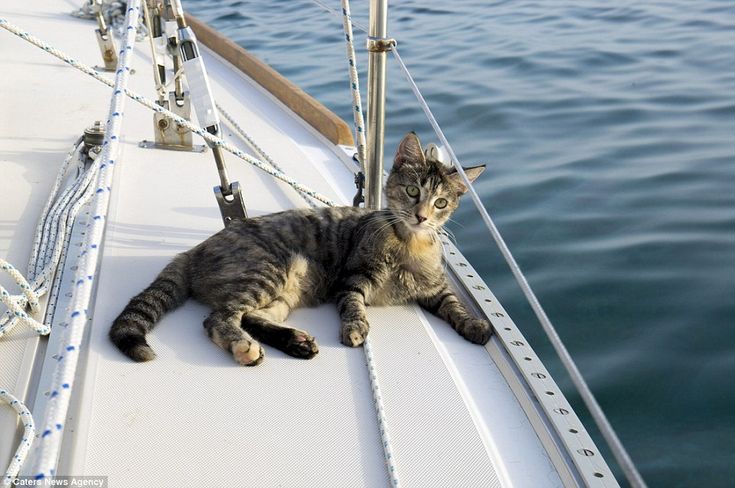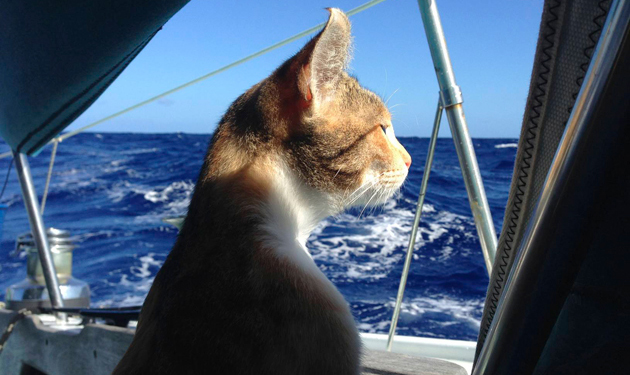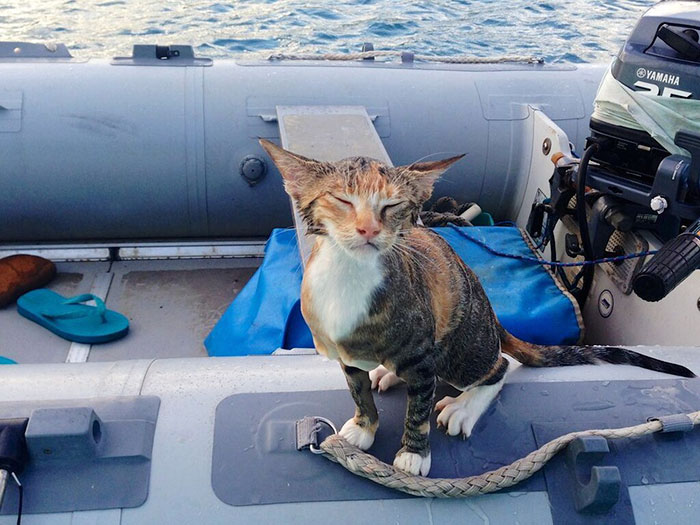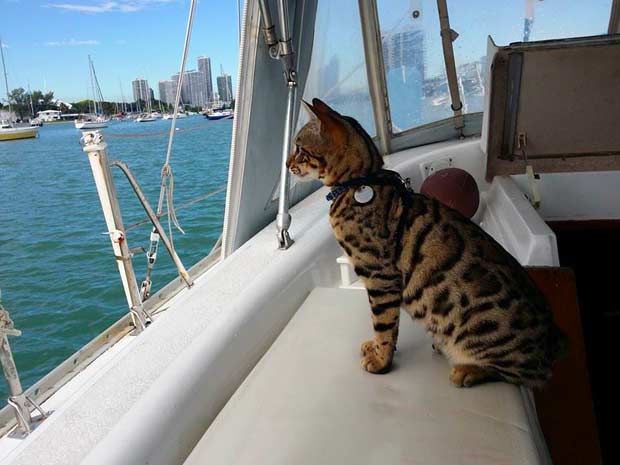Table of Contents
Safe sailing with cats on board
There are many websites on the subject of ship’s cats on the Internet that advertise very questionable drastic treatments. For example, it states that cats should be regularly thrown into the sea so that they can learn to climb on board. Others recommend swimming lessons with a life jacket. Such activities may be fun for a hyperactive young cat, but should by no means be taken as recommendations for all cats.

A sensitive cat would be traumatized by such rough treatment, could easily lose trust in their family and become too frightened to even venture on deck. In addition, cats are prone to kidney problems and a good sip of sea water when falling into the water or the swallowed dose of salt when cleaning afterwards are certainly not healthy. In many South Pacific atolls, reef sharks also like to circle around the boat and a floating ball of fur could easily end up as shark bait.
Before the cat even came on board, we should have stretched a railing net around the boat so that it couldn’t slip off the deck by mistake. Especially on the aluminum deck of your yacht their claws cannot find a hold. Then we should show disgusting, wet water around the boat.
Cats can swim instinctively in an emergency, so trying to teach them the front crawl or breaststroke is unnecessary. If the boat doesn’t have a bathing ladder or the cat doesn’t get along well with ladders, a thick rope can also be hung from the deck into the water, which would serve as a ladder in an emergency. As training, however, it is sufficient to let the cat climb over the rope from the dinghy.

At first you should also try to take her on shore excursions, but these excursions can be too stressful for her, she can jump back into the dinghy and whine loudly that she wants to go home. For more adventurous cats, however, walks on the beach are certainly a welcome change, so a harness and leash can be a sensible purchase.
Before crossing, you should always pack a waterproof emergency pack and always a dry bag. In the worst case scenario, you can stuff the cat into this before you have to leave the sinking ship.
A cat-friendly boat
It is not necessary to spend a lot of money to make a boat cat-friendly. A few simple things make life on board more pleasant and comfortable for cats. For example, you can install a cat flap in the companionway boards, so even when you’re on land, your fluffball could go on deck and didn’t have to sit in the stuffy, hot interior. Cats like to curl up in safe hiding spots, especially when the boat is rocking. So there should always be a few boxes lying around, which your cat can use as sea berths.

Health
In Europe, there is a vet in every city. In the South Pacific, however, veterinarians are scarce away from urban centers. It therefore makes sense to have the most important cat medication, such as antibiotics or painkillers, in the on-board pharmacy. It is also important to have the contact details of a trusted veterinarian, who can be asked about medication and dosages for the symptoms present in an emergency.
Tip: Some medications for humans also work for cats in correspondingly lower doses. For example, if your cat receives metoclopramide/paspertin drops for stomach problems. However, never use such medication without asking beforehand, because some are harmful or even fatal to animals!
As with humans, some cats are seaworthy and others get seasick -If your cat unfortunately fell into the latter category. In the early days she would vomit at the beginning of every trip and soon the sound of the chain was enough to scare her into her box. Stugeron (a human anti-motion sickness medicine) in drop form is also great for cats. Two drops before every trip and seasickness was history. Salt is unhealthy for cats, so we washed the deck after every trip so that your fluffball didn’t get salted all over while sunbathing on the deck.
The right litter box on board
You can use a plastic box with a high rim for the litter box so that your cat will not spread any litter around the boat when she jumps out. You can have the litter box on an anti-slip mat under the table, where the ship’s movements are not too extreme, even in rough conditions.
For the litter you can use silicate litter, which is expensive but very light and incredibly efficient. If you remove solids daily, you only need to change the litter every 3 weeks. In addition, silicate is harmless to the environment and therefore no problem with disposal. Frugal ones can even wash the litter and use it multiple times! In between, you can also use sand from the beach in remote places – but only where there were no vermin making the beach unsafe (no sandflies, nonos, no-see-ums and similar biting beasts). But a sand box has to be replaced every other day, otherwise it becomes a stink bomb.
Food for the cat on board
Even in remote areas, pet food, mostly cheap brands, can be found in convenience stores. However, anyone with a fussy kitty should stock up on quality cat food in bulk whenever it can be found. After a catch, the daily menu can also be expanded with fresh fish, many cats love fish!

Bureaucracy
Traveling with a cat within the EU is not a problem, provided you have an international vaccination card with regular rabies stamps and a titer certificate issued by an EU laboratory. As soon as you get to the Caribbean, you start declaring the cat at check-in . Whether it’s Suriname, Tobago, Grenada, Bonaire, Curacao, Colombia or Panama. French Polynesia is also very relaxed overall when it comes to regulations. Here it is possible to import a cat after 6 months of quarantine on board, counting the time at sea. Then the whole thing is just a formality that is quickly completed in Tahiti with a little paperwork and fees. If the cat stays on board, no import is necessary.
When entering small island states in the South Pacific, the following generally applies: Animals must remain on board. The officials react rather amused when you show the kitty the international passport. Attention: Fiji, New Zealand and Australia have stricter regulations that are constantly changing, so you should definitely inform yourself and prepare before entering the country.
Conclusion
In summary, having a cat on board makes cruiser life a bit more complicated. Unlike other sailors, you’re never able to make extensive domestic trips or stay home because you can’t / don’t want to leave your cat alone. It is not possible to call at all destinations and you have to take this into account when planning your trip.